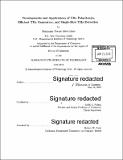| dc.contributor.advisor | Keith A. Nelson. | en_US |
| dc.contributor.author | Ofori-Okai, Benjamin Kwasi | en_US |
| dc.contributor.other | Massachusetts Institute of Technology. Department of Chemistry. | en_US |
| dc.date.accessioned | 2016-10-25T19:50:58Z | |
| dc.date.available | 2016-10-25T19:50:58Z | |
| dc.date.copyright | 2016 | en_US |
| dc.date.issued | 2016 | en_US |
| dc.identifier.uri | http://hdl.handle.net/1721.1/105042 | |
| dc.description | Thesis: Ph. D., Massachusetts Institute of Technology, Department of Chemistry, 2016. | en_US |
| dc.description | Cataloged from PDF version of thesis. | en_US |
| dc.description | Includes bibliographical references (pages 215-234). | en_US |
| dc.description.abstract | In this thesis, I describe work aimed at improving the two primary terahertz platforms that are used within the Nelson group: terahertz polaritonics and free space high field terahertz spectroscopy. The terahertz polaritonics platform consists of a thin slab of electro-optic material in which terahertz frequency radiation is generated, manipulated, and detected. The platform is unique in that the teraherz fields can be recorded using phase-sensitive imaging technique to observe the full spatiotemporal evolution of the field. In the free space regime, the terahertz field propagates in free space between a transmitter and a receiver. By using appropriate crystals and focusing optics, it is possible to achieve high field strengths capable of driving nonlinear responses in materials. The first project presented describes improvements to the two imaging techniques used: phase contrast and polarization gating. By using improved optical designs and detection hardware, we obtained a best image resolution of 1.5 [mu]m (< [lambda]/100 at 0.5 THz) using polarization gating, and a noise floor of 0.1% for polarization gating. Using the low noise floor of polarization gating imaging, we demonstrate for the first time the ability to perform time resolved imaging of terahertz waves propagating within a photonic crystal slab. For photonic lattices with different orientations and symmetries, we observed the full spatiotemporal evolution of terahertz fields across a broad spectral range spanning the photonic band gap. In addition to revealing real-space behavior, the data let us directly map the band diagrams of the photonic crystals and observe the behavior of leaky waves and the individual components of the photonic crystal Bloch states. The next set of projects uses the free space geometry. We first present a novel method for THz generation in lithium niobate using a reflective stair-step echelon structure. The echelon produces a discretely tilted pulse front with less angular dispersion compared to a high groove-density grating. We produced THz pulses with field strengths as high as 500 kV/cm and pulse energies as high as 3.1 [mu]J. The highest conversion efficiency we obtained was 0.33%. Following this we discuss a method for single-shot detection of terahertz pulses using a pair of transmissive echelons. Finally, efficient THz generation and single-shot detection were combined to probe the effects of optical excitation in three solid state systems. The first was the semiconductor tin (II) sulfide, where optical pump terahertz probe spectroscopy was used to determine optimal conditions for sample growth to improve solar cell devices. These measurements revealed that by annealing and surface treatment, the carrier lifetime of tin sulfide can be extended, thereby improving device performance. The next was the metal-halide chain platinum iodide where optical pump-terahertz probe spectroscopy was used carrier self trapping. The results obtained here indicate that following photoexcitation liberated carriers are trapped on the 100s of femtosecond timescale. Lastly, optical pump single-shot terahertz probe measurements were used to study the dynamics of a photoinduced insulator-to-metal phase transition in the correlated electron material calcium doped lanthanum manganite. The data indicate that on the 1 picosecond to 1 nanosecond timescale there is limited change in the conductivity of the material, suggesting that large scale domain growth is required in order for the material to reach the final metallic state. | en_US |
| dc.description.statementofresponsibility | by Benjamin Kwasi Ofori-Okai. | en_US |
| dc.format.extent | 234 pages | en_US |
| dc.language.iso | eng | en_US |
| dc.publisher | Massachusetts Institute of Technology | en_US |
| dc.rights | M.I.T. theses are protected by copyright. They may be viewed from this source for any purpose, but reproduction or distribution in any format is prohibited without written permission. See provided URL for inquiries about permission. | en_US |
| dc.rights.uri | http://dspace.mit.edu/handle/1721.1/7582 | en_US |
| dc.subject | Chemistry. | en_US |
| dc.title | Developments and applications of THz polaritonics, efficient THz generation, and single-shot THz detection | en_US |
| dc.type | Thesis | en_US |
| dc.description.degree | Ph. D. | en_US |
| dc.contributor.department | Massachusetts Institute of Technology. Department of Chemistry | |
| dc.identifier.oclc | 959710530 | en_US |
